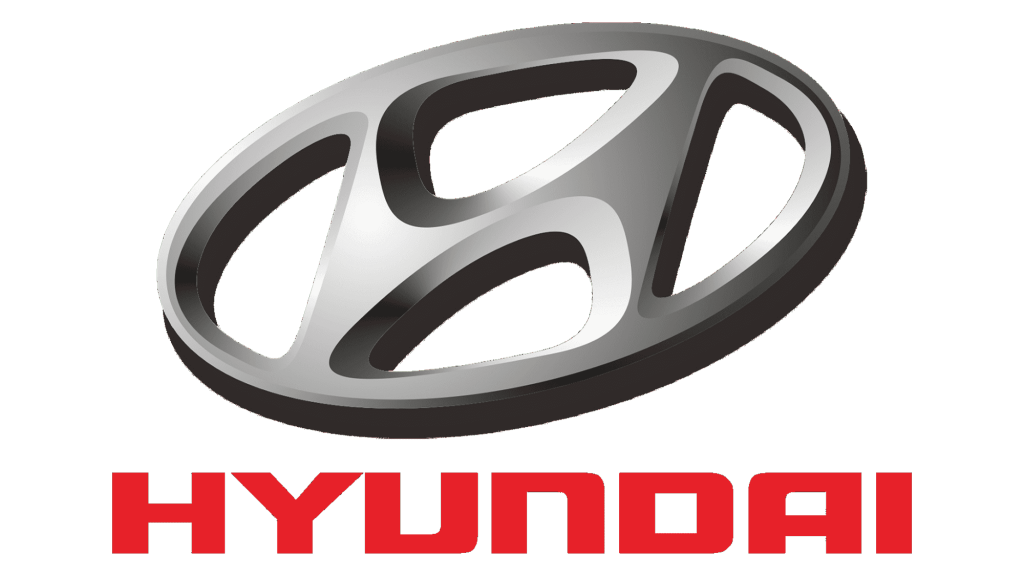Hyundai Motor is the largest car manufacturer in Korea and one of the largest in the world. Since 1967, the day of company’s launch, they’ve been creating all sorts of general use cars. As a result of their extreme success, their cars are a common sight in Asia, right next to the Japanese leviathans.
Meaning and History
From Korean, the name is translated as ‘modernity’, which is a hint at their focus on innovation and technological superiority. Their logo, however, has mostly been pretty boring over the course of the history. In the recent decades, it’s mostly just been a Latin H letter stuck inside an oval ring.
1969 – 1970
Their first ever logo (created 2 years after the start) also featured the Latin letters – two of them, in fact. They were both black, thick and tilted to the right a bit. The first letter H also was a bit taller than its neighbor D (also taken from the company name). But in essence, there was nothing special about them.
Both letters were featured in front of the rectangular shape that lay somewhat in perspective. And finally, the whole construction was encircled by a big black ring, which, however, was shifted to the right a bit (the left edges of the rectangle stuck out of its side). The upper half of the circle was also uncomfortably empty.
1970 – 1978
One year later, they decided that the circle was indeed unpleasant to look at. Consequentially, it was made into a slightly wider oval to accommodate both the lettering and the rectangle, as well as leave no uncomfortable gaps inside. The experiment made the logo a lot more attractive.
1974 – 1992
Hyundai’s logo consisted of bold black letters “HD” in a black frame. At the same time, one of the sides of the letter “H” was the basis for the letter “D”.
1980 – 1992
For 14 more years the emblem of this company didn’t resemble what they have now in the slightest.
This version also featured a combination of H and D, although now they were much fatter (for the lack of the better word), dark blue and put in the small wide rectangle. The majority of the free space on the logo was occupied by a large writing that said ‘Hyundai’ in Korean (also in dark blue).
At this stage, the HD combo was used as an emblem for the cars, because the English wasn’t yet as widespread here and it was considered a fairly unique image.
1990 – 2003
By 1990, Hyundai has already gone international, which dictated a need for having a universal logotype. Although the previous logo has still been in use for 2 more years, it was gradually replaced by this version even at home.
This logo features a tilted H letter surrounded by an oval. The entire image is colored blue. In fact, the letter looks seems to be inspired by the letter N as well, but it’s just an artistic choice.
During this period Hyundai also created two more logos for different occasions. Here they come.
2003 – now
Like on the pre-92 version, they added a company name to the right of the main logotype. The color remained the same as the previous variant. The writing had a fairly blocky look – abrupt angles, linear composition, etc. They use this version of the logo whenever they need to put their name in priority.
2011 – 2017
This temporary logo was pretty much the same as the one above, although the image part is dunked heavily in polish and looks metallic. It’s much better than the previous variant, but the writing didn’t change. It did shift from right to beneath the logo, but that’s pretty much it.
They used it in commercials and other promotional material, but then got rid of it because polished emblems fell out of fashion than anything else.
2023 – now

The updated logo looked familiar yet the designers were able to give it a modern and sleek appearance. First of all, they brought back the classic and timeless black-and-white color palette. The oval shape was black, allowing the white initial to stand out. The stylized “H” looked flat and its shape resembled the shape of the letter seen in the previous logo, only without the 3D effect.
Emblem and Symbol
Most Hyundai cars still sport a polished metallic company logo as shown in the 2011 commercial variant. They put one on the front of the car without much preference of exact positioning, and another identical emblem is usually placed on the back of an automobile, also without preference.









